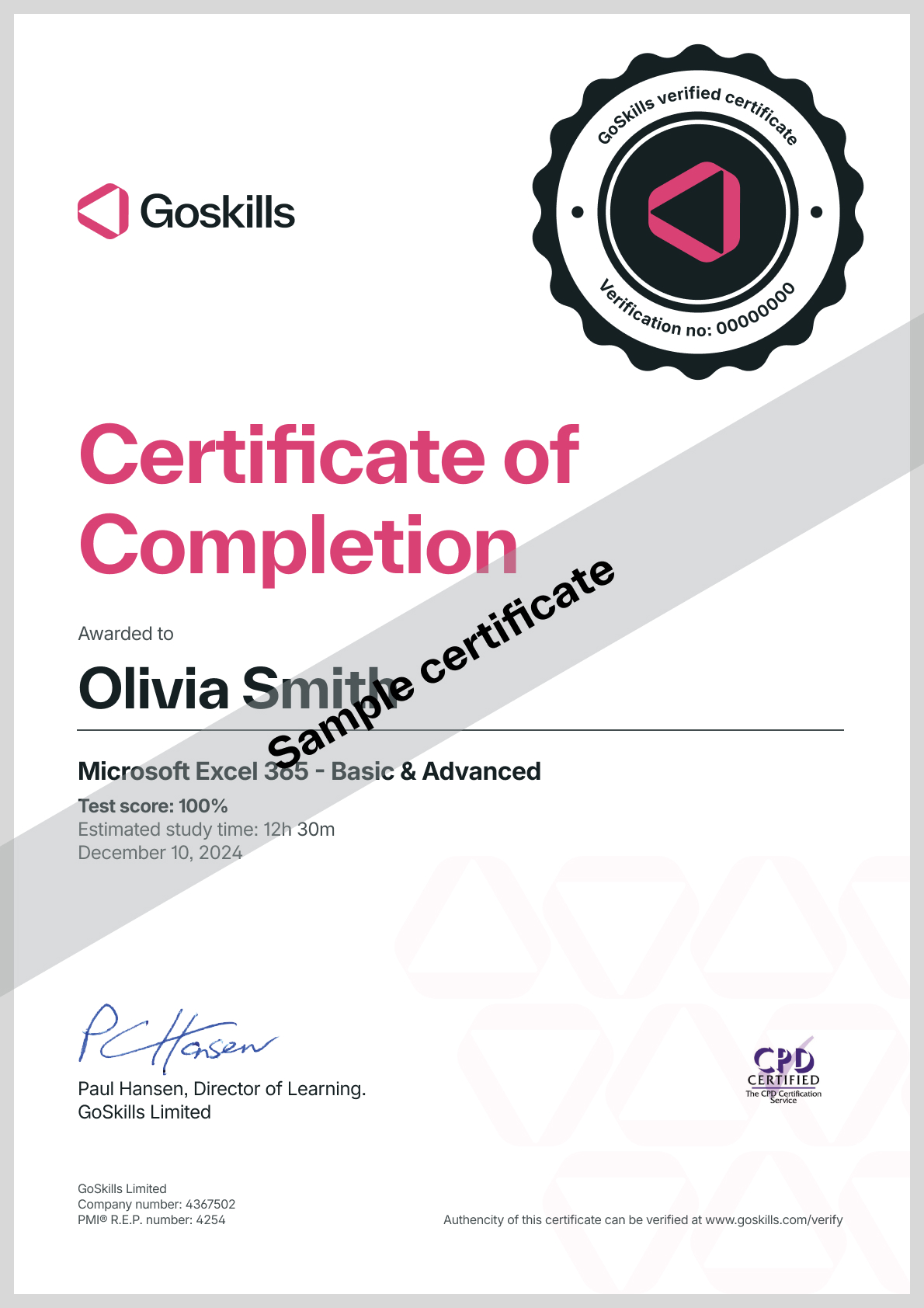Project Management Framework
Project Management Framework
Skills you’ll gain
Whether it’s your first project or your fiftieth, adhering to a project management framework builds confidence and eliminates guesswork, bringing you closer to project success. In this Project Management Framework training course, you’ll learn the foundations and structure of traditional and Agile Scrum frameworks, helping you standardize your processes and account for factors that could impact your project’s execution and delivery.
By the end of this Project Management Framework course, you’ll be able to:
- Understand the benefits of working within a project management framework and the governance of project management business practices.
- Lay the groundwork for a successful project.
- Plan, organize and structure your projects according to today’s best practices.
- Avoid common errors by approaching your projects through the lens of project risk management.
- Identify goals, objectives, boundaries, and constraints before launching your project.
- Understand traditional and Agile Scrum frameworks with 30 engaging lessons that include real-world examples and actionable exercises.
- Earn 15 PDUs or contact hours toward your Project Management education for certification with PMI.
This course is based on The Project Management Institute,
If your goal is to become a Certified Project Management Professional, this course is an ideal starting point. Once you’ve mastered the tools and techniques in this Project Framework course, we recommend taking our Project Teams and Stakeholders, Project Planning, and Project Performance and Delivery.
Once enrolled, our friendly support team and tutors are here to help with any course-related inquiries.
Syllabus
Download syllabus-
1
Project Management Methodology There are many approaches to project management, each with strengths and weaknesses. Understanding the major approaches will assist the organization is the selection of the approach that is appropriate for the unique project goals and constraints. 6m
-
2
Methodology Comparisons The three approaches presented are three very different ways of managing a project. Understanding the differences will enable a business to select the best approach for their projects. 7m
-
3
Sprint-Scrum Process The Agile/Scrum methodology is a structured project management methodology. It follows a prescribed process that includes Sprints and Scrums. 5m
-
4
Project Phases Projects are often organized into phases. Phases provide structure and logic to the project and aid the project team and management to track progress. 6m
-
5
Project Management Domains Understanding the domains found in the PMBOK® Guide will prepare an individual to manage a project. These domains are universally applicable across industries and project types and are essential aspects of project management throughout the project lifecycle. 4m
-
1
Positive and Negative Risk Understand the difference between positive and negative risk. Learn the major steps of project risk management. 5m
-
2
Risk Register The Risk Register is a table that tracks the project risk management activities. 4m
-
3
Risk Identification Risk Identification is the practice of identifying positive and negative conditions that may occur within the project and impact project objectives. 5m
-
4
Risk Matrix All project risks are not equal in their effect on a project. Project risks that have been identified are prioritized using qualitative techniques such as the Risk Matrix. 5m
-
5
Negative Risk Response Negative Risk Response is determining what actions the project will take to address risk threats. 6m
-
6
Positive Risk Response Positive Risk Response is determining what actions the project will take to address risk opportunities. 5m
-
7
Contingency and Triggers Contingencies are potential risk response actions that will only be implemented if some triggering event or condition has shown that the risk probability has gone from unlikely to likely. 4m
-
1
Project Benefits Every project has a purpose. Determining that purpose, the benefits to the organization and how they will be measured is a fundamental principle for project success. 6m
-
2
Creating a Business Case The business case provides the business rationale, normally in financial terms, of whether the project should be done. 6m
-
3
Project Charter The Project Charter is the document that approves the initiation of the project and identifies goals, objectives, boundaries, and constraints. 5m
-
4
Requirements Planning Project requirements are often vague, incomplete, or contradictory at the time of project initiation. Normally, additional effort is required to collect and verify the true project requirements. 4m
-
5
In-Frame/Out-of-Frame In-Frame/Out-of-Frame is a technique for clarifying project boundaries by listing both the activities and deliverables that are in scope for the project and listing the activities that are not required as part of the project. 4m
-
6
Primary Constraint The approach taken when planning a project should be based upon the primary project constraint. Attributes of that constraint are planned first and then other aspects of the project are planned to support the primary constraint. 4m
-
7
Project Selection and Approval The organization needs to establish a management discipline for selecting and approving projects. 6m
-
1
Project Governance Project governance builds trust and confidence in project management. While there are many ways to approach governance, most organizations rely upon a Project Management Office to perform this function. 6m
-
2
Compliance Categories Project requirements encompass more than the functional requirements. There are government, industry, and organizational requirements with compliance attributes that must be managed. 6m
-
3
Governance Impact An organization and project team can take several approaches for ensuring compliance. Regardless of the approach there are significant impacts of both compliance and non-compliance. 6m
-
4
PMBOK® Guide The PMBOK® Guide is the reference document upon which much of the PMP® exam is based. The PMBOK® Guide contains a description of project management domains, models, methods, tools, checklists, and templates. 4m
-
5
Project Management Standard A portion of the PMBOK® Guide is a standard for project management. That portion is Part 1, The Standard for Project Management of a Project. 3m
-
6
PMIS and Project Management Software The Project Management Information System (PMIS) is the method that the project manager and core team use to share and disseminate project information. It often is based upon the use of a project management software application. 6m
Certificate
Certificate of Completion
Awarded upon successful completion of the course.

Instructor
Ray Sheen
Ray is a certified Project Management Professional (PMP) with the Project Management Institute, a certified Scrum Master with Scrum Alliance, and certified Lean Six Sigma Black Belt with IASSC. He is a member of the Project Management Institute and the Product Development Management Association.
He is president and founder of Product & Process Innovation, Inc. and is a veteran business leader with over 25 years of executive, project management, and engineering management experience. Ray has worked in several industries including aerospace, electrical distribution and utilities, biotechnology, appliances, electronics, machining, medical devices, pharmaceutical, automotive, and financial services. He has held executive management positions in a Fortune 500 company and has been involved in entrepreneurial startup organizations.

Ray Sheen
Project Management Instructor & Author
Accreditations
Link to awards PMI, PMP, CAPM and PMBOK are registered marks of the Project Management Institute, Inc.How GoSkills helped Chris
I got the promotion largely because of the skills I could develop, thanks to the GoSkills courses I took. I set aside at least 30 minutes daily to invest in myself and my professional growth. Seeing how much this has helped me become a more efficient employee is a big motivation.


